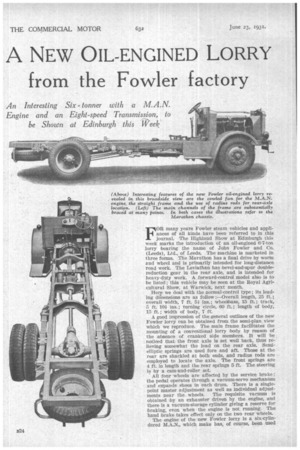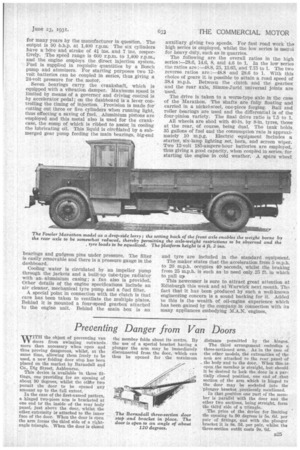A NEW OIL-ENGINED LORRY from the Fowler factory
Page 38

Page 39

If you've noticed an error in this article please click here to report it so we can fix it.
An Interesting Six former with a M.A.N. Engine and an Eight-speed Transmission, to be Shown at Edinburgh this Week
FOR many years Fowler steam vehicles and appliances of all kinds have been referred to in this journal. The Highland Show at Edinburgh this week marks the introduction of an oil-engined 6-7-ton lorry bearing the name of John Fowler and Co. (Leeds), Ltd., of Leeds. The machine is marketed in three forms. The Marathon has a final drive by worm and wheel and is primarily intended for long-distance road work. The Leviathan has bevel-and-spur doublereduction gear in the rear axle, and is intended for heavy-duty work. A forward-control model also is to be listed ; this vehicle may be seen at the Royal Agricultural Show, at Warwick, next month.
Here we deal with the normal-control type; its leading dui/tensions are as follow :—Overall length, 25 ft.; overall width, 7 ft. 5i ins.; wheelbase, 15 ft.; track, ii ft. 10i ins.; turning circle, BO ft.; length of body, 15 ft.; width of body, 7 ft.
A good impression of the general outlines of the new Fowler lorry can be obtained from the semi-plan view which we reproduce. The main frame facilitates the mounting of a conventional lorry body by reason of the absence of cranked side members. It will be noticed that. the front axle is set well back, thus relieving somewhat the load on the rear axle. Semielliptic springs are used fore and aft. Those at the rear are shackled at both ends, and radius rods are employed to locate the axle. The front springs are 4 ft. in length and the rear springs 5 ft. The steering is by a cam-and-roller set.
All four wheels are affected by the service brake; the pedal operates through a vacuum-servo mechanism and expands shoes in each drum. There is a singlepoint master adjustment as well as individual adjustments near the wheels. The requisite vacuum is obtained by an exhauster driven by the engine, and there is a vacuum-storage cylinder giving a reserve for braking, even when the engine is not running. The hand brake takes effect only on the two rear wheels.
The engine of the new Fowler lorry is a six-cylindered M.A.,.N, which make has, of course, been used for many years by the manufacturer In question. The output is 90 b.h.p. at 1,400 r.pair. The six cylinders have a. bore and stroke of 41 ins. and 7 ins. respectively. The speed range is 600 r.p.m. to 1,400 r.p.m„ and the engine employs the direct injection system. Fuel is supplied in requisite quantities by a Bosch pump and atomizers. For starting purposes two 12volt batteries can be coupled in series, thus giving a 24-volt pressure for the motor.
Seven bearings carry the crankshaft, which is equipped with a vibration damper. Maximum speed is limited by means of a governer and driving control is by accelerator pedal; on the dashboard is a lever controlling the timing of injection. Provision is made for cutting out three or five cylinders when running light, thus effecting a saving of fuel. Aluminium pistons are employed and this metal also is used for the crankcase, the sump of which is ribbed to assist in cooling the lubricating oil. This liquid is circhlated by a submerged gear pump feeding the main bearings, big-end bearings and gudgeon pins under pressure. The filter is easily removable and there is a pressure gauge in the dashboard.
Cooling water is circulated by an impeller pump through the jackets and a built-up tithe-type radiator with an aluminium casing; a fan also is provided. Other details of the engine specifications include an air cleaner, mechanical tyre pump and a fuel filter. A. special point in connection with the clutch is that care has been taken to ventilate the multiple plates. Behind it is mounted a four-speed geaitox attached to the engine unit. Behind the main box is an auxiliary giving two speeds. For fast road work 'the high series is employed, whilst the low series is useful for heavy duty, such as in quarries.
The following are the overall ratios in the high series:-28.6, 14.6, 8, and 4.6 to 1. In the low series the ratios are :-48.8, 25, 13.65, and 7.75 to 1. The two reverse ratios are :-48.8 and 28,6 to 1. With this choice of gears it is possible to attain a road speed of 38.4 m.p.h. Between the clutch and the gearbox and the rear axle, Simms-Jurid universal joints are used.
The drive is taken to a worm-type axle in the case of the Marathon. The shafts are fully floating and carried in a nickel-steel, 'one-piece forging. Ball and roller bearings are used and the differential is of the four-pinion variety. The final drive ratio is 7.5 to 1.
All wheels are shod with 40-in. by 8-in. tyres, those at thefl rear, of course, being dual. The tank holds 35 gallons of fuel and the consumption' rate is approximately 10 m.p.g. Electric equipment includes a starter, six-lamp lighting set, horn, and screen wiper. Two 12-volt 185-ampere-hour batteries are employed, thus giving a good capacity, when coupled in series, for starting the engine in cold weather. A spare wheel
and tyre are included in the standard equipment
The maker states, that the acceleration from 5 m.p.h. to 20 m.p.h. occupies 4&. seconds, whilst the braking from 25 m.p.h. Is such as to need only. 25 ft. in which to pull up
This newcomer is sure to attract great attention at Edinburgh this week and at Warwick next month. The fact that it has been produced by such a well-known engineering concern is a sound backing for it. Added to this is the wealth of oil-engine experience which has been gained by .the company in connection with its many appliances embodying MAN.. engines,.




























































































